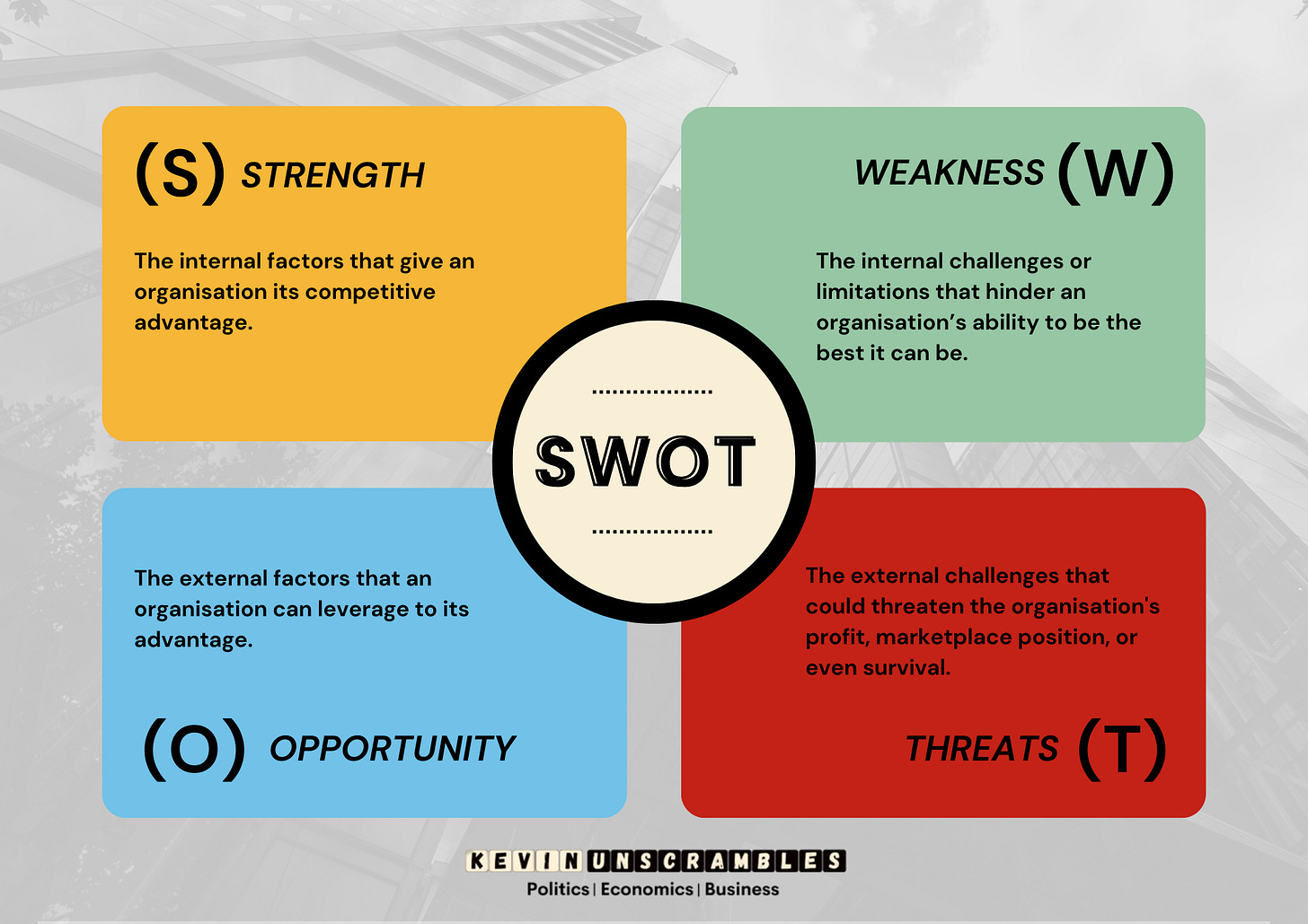Don’t Sweat It, SWOT It
Here is a tool that assesses risks and helps capitalise on new opportunities
In times of disruption, whether driven by political shifts, economic volatility, or changing customer demands, businesses face challenges that can threaten stability, reshape competition, and even redefine their core values. Political shifts, such as changes in leadership or trade policy, or economic fluctuations, such as inflation, currency volatility, or even the prospect of recession, can significantly impact a business organisation’s outlook, stability, and growth.
Navigating these dynamics often requires transformational change, including overhauls of operations, business models, or organisational culture. To succeed, business leaders need analytical tools that balance agility with strategic foresight, enabling them to assess risks, capitalise on new opportunities, and make informed decisions for the future.
The SWOT analysis (Strengths, Weaknesses, Opportunities, Threats) is a well-established strategic framework that helps organisations map their internal capabilities (strengths and weaknesses) against external conditions (opportunities and threats) at a particular point in time. Its power is in its simplicity, making it a great starting point for structured strategic planning in many situations, particularly when used objectively and paired with data-driven insights.
When used as part of a broader change management strategy, SWOT can help kickstart the process of turning uncertainty into opportunity. It allows organisations to optimise internal strengths in light of external opportunities while also addressing internal weaknesses and mitigating external threats. Thus, conducting a SWOT analysis should be one of the first steps for a business organisation to take to maintain a competitive edge and succeed through periods of disruption.
So, let's look at what is involved.
What is Involved in a SWOT Analysis?
At its core, SWOT analysis is a strategic planning tool used to identify and evaluate four critical elements inside and outside of a business organisation. It can also be used in other settings such as government, non-profit organisations, by individual teams within a business, or even individuals in their career planning.
The four factors can be divided into two categories: internal and external.
Internal
Strengths (S): These are the internal factors that give an organisation its competitive advantage, such as its trusted brand, quality of product, financial resources, expertise, and market position.
Weaknesses (W): These are the internal challenges or limitations that hinder an organisation’s ability to be the best it can be. This could include the persistence of a poor organisational culture, skill gaps, or the use of outdated technology.
External
Opportunities (O): These are the external factors that an organisation can leverage to its advantage, such as the ability to enter emerging new markets, the deployment of new technology, regulatory changes, or shifts in customer preferences that are more aligned to the organisation’s product offering.
Threats (T): These are the external challenges that could threaten the organisation's profit, marketplace position, or even survival. These include increased competition, new regulations or trade barriers, economic downturns, or technological disruption.
A Real-World Example: SWOT in Action
A manufacturing company might turn to an initial SWOT analysis to guide its strategic response when faced with the prospect of new tariff barriers in a key market. Internally, it could leverage its recognised product excellence and operational efficiency as an identified strength.
At the same time, it may identify dependence on specific cross-border supply chains as a weakness that needs to be addressed. Furthermore, a crisis can serve as a catalyst for necessary change. Thus, a SWOT analysis can empower the organisation to confront internal weaknesses head-on, such as identifying internal gaps in resources, capabilities, or processes that are holding back its agility.
Change often brings new possibilities; the company might identify new or underdeveloped markets as opportunities for future growth. By aligning with emerging market trends, it can ensure that it not only survives but also emerges even stronger.
As the key threat is the tariff barriers themselves, this may require more proactive responses, such as setting up a regional production facility in the target market or collaborating with industry associations and trade chambers to engage policymakers in support of fair and rules-based trade.
Don’t Sweat it, SWOT it
Change is constant in business; thus, transformational change is inevitable. Conducting a SWOT analysis provides businesses with the initial insights they need to assess their strengths, weaknesses, and the threats and opportunities that confront them.
Though a simple framework, conducting a SWOT analysis as an initial step in a change management strategy gives organisations initial clarity on what their priorities should be. It works best as a snapshot rather than a roadmap, so it should form part of a wider portfolio of analytical tools that can be used at different stages in a process of transformational change. Sustained success also depends on execution, iteration, and adapting to new information as it becomes available. When facing the maze of uncertainty that comes with disruption, SWOT should be one of the first tools in your strategic arsenal. Get it right early—and there’s no need to sweat it, just SWOT it!




